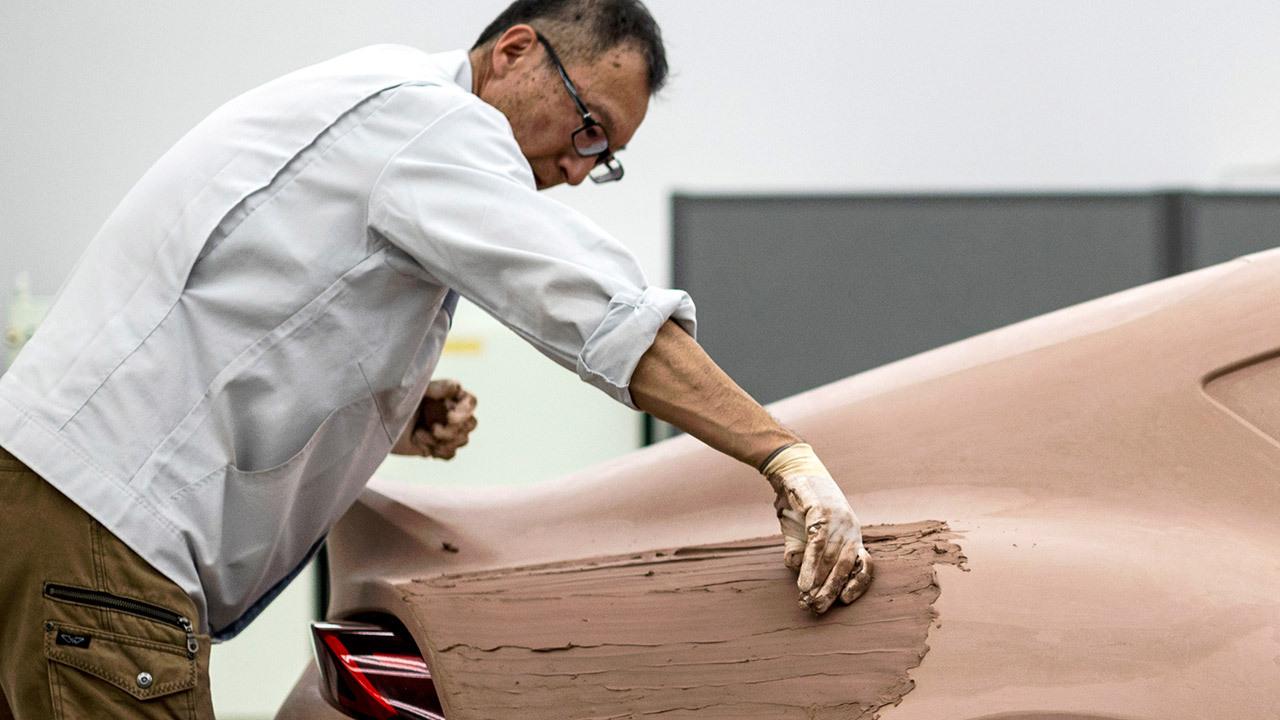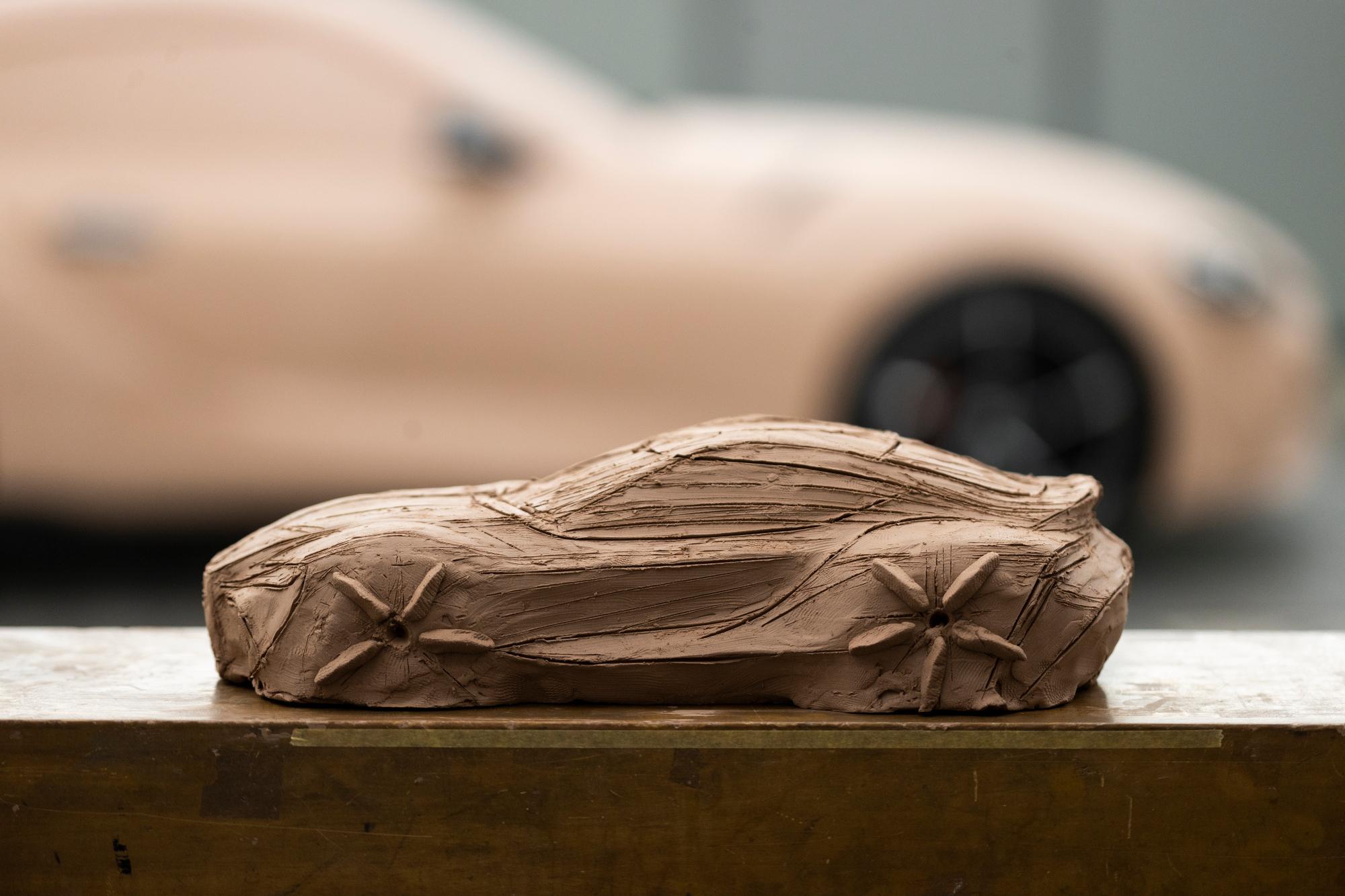
Kazushi Eto, clay modeling master. "The craft behind Japan's car making excellence."

While many people focus on advanced technologies such as 3D printing or AI when thinking about innovation, much of the work involved in car manufacturing is still done by hand.
In this series, by interviewing some of the masters supporting Toyota’s manufacturing with their craftsmanship, Toyota Times uncovers the essence and core strength built on traditional Japanese monozukuri (making things).
The seventh interviewee is Kazushi Eto, a master of clay modeling.

Series #7 Master Modeler Kazushi Eto gives shape to designers’ ideas in 3D
Chief Expert, Model Creation Section No. 1, Design Management Division, Vehicle Development Center at Toyota Motor Corporation
Deft hands create a rough model as if by magic
In minutes, three simple, unassuming rolls of industrial clay, 30cm long with a diameter of 5cm, warmed to about 68℃, are transformed into an almost living shape.

The modeler first applies pressure to the clay with his fingertips, then takes a step back to look at the overall form, before stepping up to the clay once again, in a constantly repeated process. It is entrancing and you find your eyes riveted to the clay as it takes shape. All this takes place in a design studio at Toyota Motor Corporation in Toyota City, Aichi Prefecture.
The scene you see developing before your eyes is almost a kind of dramatic performance. What feels like just a couple of minutes actually takes more than ten. The time slips by as the modeler deftly brings to life the dynamic form of a GR Supra.

Demonstrating his skills is Kazushi Eto. He is a clay modeler working in the Model Creation Section No. 1, Design Management Division of the Vehicle Development Center, and has 27 years of career experience under his belt. As Chief Expert (CX) he has a leading role in developing exterior designs for various vehicles and is also focusing his energies on nurturing clay modelers of the future.
In his demo, Eto created a palm-sized model. He says, “These kinds of concept models, which we create when designing a new car, are required to present in 3D model form an attractive image of the new car concept as drawn by the designer. What we try to achieve is an exaggerated form that enables us to confirm with the designer the concept that is being aimed for.”
The clay modeler—another major player in the car design process
While a car is a means of transportation, it is also a special product that appeals to people’s emotions. People choose their favorite car based on the emotions and excitement they feel when they stand in front of it. What kind of things could happen to me if I drove this car? What kind of world could open up to me? The most decisive element of any vehicle that responds to those questions, the one that determines emotional attraction, is its exterior design (styling).
Vehicle styling is also directly linked to the corporate image of automobile manufacturers. When people think of cars, they usually think of a particular vehicle that represents a specific brand. You could say that car design equates to corporate image design.
Car designers take on the mantel of designing this corporate image through car design. In addition, clay modelers play a major role in the car design process.

Clay modelers are technicians who work in partnership with designers to create 3D models of vehicle designs. Their work is to understand the intention behind the designer’s concept sketches, and then create a 3D model from that image using clay.
One of the roles of the clay modeler in the new vehicle design development is to create a concept model, such as the one introduced above, from the new car image concept sketches where the designer uses pencil, marker or a computer. Eto himself says that in the modeling process at Toyota, he inherited a development style from his predecessors that utilizes the creativity of the modeler, in evoking the shape from the designer’s sketches.

The leap from a two-dimensional concept sketch to a 3D clay model is greater than one would imagine. The clay modeler’s job starts with detailed discussions with the designer and then they must use their own creativity to bridge the gap between the two media and ultimately eliminate that gap.
“The first thing that a clay modeler needs is the ability to ‘read shapes’ from the two-dimensional information provided in the designer’s sketches and blueprints. Beyond what the designer wants to express in a two-dimensional sketch, there are many inconsistencies that cannot be given shape, and also many elements that may not be drawn or expressed in the sketch.”
It is the clay modeler’s job to fill in these blanks, using all the sense, experience, skills and ideas they can muster to ultimately create a proposal that gives form to the original image of the vehicle that the designer had in mind.
Each clay modeler has their own slightly different approach to creating concept models. Like Eto, there are modelers who take a freehand approach, eschewing all modeling tools and using just their fingertips to intuitively create a rough shape, and there are also those who take a more structural approach, using modeling tools.
“My preference is for this style of modeling, in order to get an immediate sense of the 3D image. This is because I can then confirm with the designer the specifics of their idea.”
Clay modelers are a dependable partner for designers. The concept model lets the designer see and confirm how their concept sketch would look in 3D and shows where any problem areas may be. The designer can then use this feedback to make a more precise concept sketch. In turn, the modeler can use the clearer concept sketch to hone the features of the clay model.
It is through this repeated process of sketching and modeling that a new car’s beguiling style gradually becomes clearer and takes shape.
However, the role of the concept model is purely to “come up with ideas” for designing new vehicles, and there are still many stages before the design of a production vehicle reaches completion. From this point, the modelers work together with the designers to make sure that the idea becomes a reality. (This process is introduced in part 2)

“The artistic and modeling skills required of the clay modeler are not limited to concept models. While first we must give shape to the ideas and specific focuses of the designer, ultimately we must seek to create the form of a stable vehicle. This is because any shape that looks unstable causes people to worry.
It is important to grasp such points in communication with the designer. Those points guide me when I read the light and shadows in the sketch to visualize what parts of the vehicle body should be in what proportions, seeking to create a shape that closely resembles the sketch and also looks stable as a vehicle.”
Eto continues, “However, the clay modeler is not an artist. While focus and passion are important, we must retain a sense of humility. The key point of our job is to work closely and in step with the designer to seek out answers.”
Even so, the sensitivities, creativity, experience and skills of the clay modeler play an incredibly important role in creating concept models. Above all, it is the clay modeler and their hands that give the ideal shape.
“If two clay modelers attempt to create an image model from the same car designer’s sketch, the resulting models will be totally different. So, whose 3D interpretation is closest to being correct? The most interesting and exciting part of this job is to create while still evoking the designer’s ideas.”
Love of cars led to clay modeling

In his current position as Chief Expert, Eto focuses his energies on leading Toyota’s clay modelers and providing guidance to the next generation. But how did he come into this career himself?
Eto was born in May 1971 in Tsu City in Mie Prefecture. His father was a carpenter, and watching and learning from his father’s ability to create anything himself helped Eto become proficient at craftwork from a young age. He also had a love of cars and started visiting motor shows and race tracks from his elementary school days.
“I was interested in the shape and mechanisms of cars and loved racing from childhood, so I often went to the nearby Suzuka Circuit with my parents. Even from that time, I knew that I wanted to work with cars. My idea back then was to become a mechanic.”
Eto says that he had previously known about the work of car designers, but the first he heard about clay modelers was at his high school career guidance office. This career option brought together Eto’s love of making things with his fascination for cars. He immediately chose the career path of a clay modeler, enrolling in the modeling course at the Kyoto Technical School of Design.
Unfortunately, the school closed in March 2008, but it was among the first in the country to create a department of automobile design, and for approximately 20 years it provided graduates for the automotive industry.
“The school offered a two-year course, with the first year concentrating on the basics of design. From the second year, we learned about the basic knowledge and skills needed for modeling. For our graduation project, a team of students created a full-scale clay model car, and I was the project leader.”
After he graduated in March 1992, Eto took the Toyota examination on the recommendation of his teacher. The exam was to create a one-fifth scale clay model, and he passed with flying colors. In April 1992 he was assigned to the Model Manufacturing Section of the Design Division, embarking on his career as a clay modeler.
“When I first entered the Toyota design studio and saw the in-progress clay models all neatly lined up on the surface plates, I truly felt that all my dreams had come true.”
Even now, Eto still occasionally thinks back to that initial feeling as he goes about his daily modeling work.

The second part of this article introduces Eto’s outstanding skills as a clay modeler with a demonstration on a full-scale model, his work and career to date, and his presence as a guide and mentor engaged in nurturing future generations on the frontlines of increasingly digital car design.
(Text: Yasuhito Shibuya, photo: Akira Maeda)

